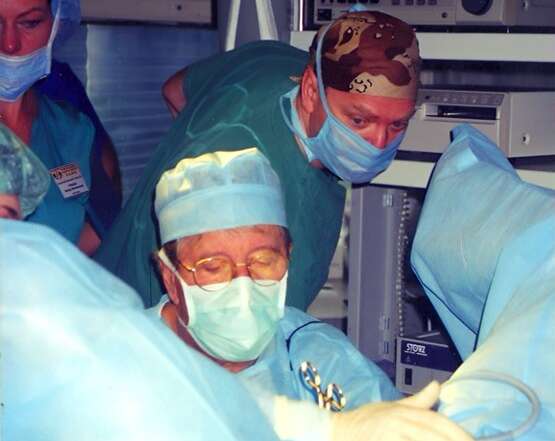Authors / metadata
DOI: 10.36205/trocar5.2025005
Abstract
The management of early-stage cervical cancer through surgery has been significantly influenced by the LACC trial, which raised concerns about the safety of minimally invasive surgery (MIS) in terms of survival. This review compares outcomes of MIS and open surgery, focusing on tumor size, sentinel lymph node biopsy (SLNB), preoperative conization, and fertility preservation. While the LACC trial highlighted a higher recurrence rate in the MIS group, evidence suggests that MIS may still be effective for smaller tumors (<2 cm) when performed by experienced surgeons. The use of SLNB has gained credibility as a reliable diagnostic tool, and preoperative conization can reduce recurrence risks, particularly for smaller tumors. Fertility-preserving surgeries have shown promising results for young patients with early-stage cervical cancer. The article concludes with a recommendation for individualized surgical strategies, emphasizing open surgery for larger tumors, and MIS for smaller ones, provided the surgeon has the required expertise.
Introduction
Plain Language Summary: This article reviews the surgical options for treating early-stage cervical cancer, focusing on two main approaches: minimally invasive surgery (MIS) and open surgery. It highlights findings from the LACC trial, which raised concerns about the safety of MIS, especially for larger tumors. The review suggests that MIS can be effective for smaller tumors, but open surgery may be better for larger ones. The article also discusses the use of sentinel lymph node biopsy and preoperative conization, as well as the importance of fertility preservation for young patients. Personalized surgical strategies are recommended, depending on tumor size and the surgeon’s expertise.
Methods
Study Design: This review follows a narrative approach to synthesize current evidence on surgical strategies for early-stage cervical cancer, comparing minimally invasive surgery (MIS) and open surgery. Literature Search: Relevant studies were identified through systematic searches in PubMed, Cochrane, and Scopus databases. Keywords included “cervical cancer,” “minimally invasive surgery,” “LACC trial,” “radical hysterectomy,” and “fertility preservation.”
Inclusion Criteria: Studies included were those that compared MIS and open surgery in early-stage cervical cancer, addressing outcomes like recurrence rates, survival, tumor size, and fertility preservation. Only peer-reviewed articles published in English were considered.
Exclusion Criteria: Articles focused on advanced cervical cancer or non-surgical interventions were excluded.
Data Extraction: Data on oncological outcomes, surgical techniques, complications, and fertility preservation outcomes were extracted from the selected studies. Statistical Analysis: A qualitative synthesis of the findings was conducted, with no formal statistical meta-analysis due to heterogeneity across studies.
Results
Debate: MIS vs. Laparotomy
Open radical hysterectomy (RH) with pelvic lymphadenectomy has long been considered the gold standard for cervical cancer, delivering high survival rates but with significant short- and long-term complications. Over the years, minimally invasive surgery (MIS), including laparoscopy and robotic surgery, has been adopted in an attempt to reduce complications while maintaining oncological outcomes. MIS was initially endorsed by various international societies, based on evidence of reduced blood loss, quicker recovery, and fewer postoperative complications (4,5). However, the 2018 LACC trial, which included randomized controlled data, revealed a higher recurrence rate in the MIS group compared to laparotomy, shifting the paradigm back toward open surgery for early-stage cervical cancer. Its findings continue to shape clinical practice and fuel debate. The role of robotic-assisted surgery in early-stage cervical cancer continues to expand. Several studies have suggested that robotic platforms may offer improved precision and reduced morbidity compared to conventional laparoscopy. Although long-term oncological equivalence remains under investigation, initial data suggest favorable outcomes in selected patients.
The LACC Trial: A Turning Point
The LACC trial, a pivotal randomized study published in 2018, evaluated the efficacy of MIS in patients with early-stage cervical cancer. The trial, which enrolled 631 patients, was halted prematurely due to concerns over higher recurrence rates in the MIS group. Key findings included a 10% difference in 4.5-year disease-free survival (DFS) between laparotomy (96.5%) and MIS (86.0%) groups. Despite adjustment for age, tumor size, and lymph vascular invasion, the survival difference remained statistically significant (6). This level I evidence directly challenged the previously held belief that MIS was non-inferior to open surgery, reigniting the debate on the optimal surgical approach.
Tumor Size and Its Impact on Survival
The size of the cervical tumor plays a significant role in predicting survival outcomes. Several studies have highlighted that smaller tumors (<2 cm) correlate with better survival rates. A Chinese study in 2022 analyzing stage IB1 tumors found no significant difference in the five year survival rate between patients who underwent MIS and open surgery for tumors ≤2 cm, but those with tumors >2 cm had worse outcomes in the MIS group (7). This suggests that MIS may be more effective in treating smaller tumors, with tumor size serving as an independent predictor of recurrence (8). It should be noted that the Chinese study (Li et al., 2022) was retrospective in design, which introduces potential limitations such as selection bias. Patients undergoing MIS may have had smaller tumors or better baseline characteristics, limiting the generalizability of the survival outcomes.
Learning Curve and Its Impact on Survival
MIS for cervical cancer requires a steep learning curve. Surgeons need experience to achieve adequate surgical margins and avoid complications. A previous Chinese study found that surgeon experience significantly impacts survival, with more experienced surgeons achieving better outcomes (7). This is consistent with findings from the LACC trial, where surgeons had to have performed at least 10 laparoscopic procedures prior to participation. The learning curve for MIS might explain some of the poor outcomes observed in less experienced hands.
Use of Uterine Manipulator in Laparoscopic Cervical Cancer Surgery
The use of a uterine manipulator during MIS for cervical cancer has been a topic of debate, with concerns that it may lead to tumor fragmentation and spread. However, recent studies, including a large cohort of 224 patients, found no significant difference in survival between those who used a uterine manipulator and those who did not (9). This suggests that the manipulator does not significantly impact recurrence rates, supporting its continued use in MIS. Recent evidence from the SUCCOR study, a European multicenter observational study, suggests that the use of uterine manipulators is associated with an increased risk of recurrence in MIS for cervical cancer. This study found that patients operated with manipulators had worse disease-free survival compared to those without. Therefore, the choice of manipulator or the decision to avoid its use altogether should be carefully considered in clinical practice. (10). A 2025 study (Spandidos Publications) showed that laparoscopic surgery without a uterine manipulator and with vaginal cuff closure achieved a 95.7% DFS in 350 patients, suggesting that technical adjustments to MIS protocols can significantly improve outcomes (11).
Impact of CO2 Gas on Survival in Cervical Cancer Surgery
During MIS, the use of CO2 pneumoperitoneum can raise concerns about potential tumor spread due to circulating CO2. Studies have indicated that intracorporeal colpotomy during laparoscopy may facilitate tumor dissemination, whilst vaginal colpotomy under CO2 pneumoperitoneum may reduce this risk. The relationship between surgical technique and tumor spread remains an area for further investigation (12).
Biopsy of the Sentinel Lymph Node in Cervical Cancer
Lymph node status is a critical prognostic factor in cervical cancer. Sentinel lymph node biopsy (SLNB) offers a less invasive alternative to pelvic lymphadenectomy, reducing complications such as blood loss, lymphocele and nerve injury. Several studies have demonstrated high sensitivity for SLNB, particularly when both technetium and blue dye are used. The AGO study group found an 88.6% detection rate, while the SENTICOL study reported a sensitivity of 92%, supporting SLNB as a reliable technique, particularly in early-stage disease (13,14,15). Various techniques are used for SLNB detection in cervical cancer, including blue dye, technetium-99m (Tc99m), and indocyanine green (ICG). ICG, in particular, has demonstrated superior detection rates and visualization when used with near-infrared imaging systems, and is becoming the preferred method in many centers due to its safety and effectiveness (16).
Conization Before Radical Hysterectomy in Early-Stage Cervical Cancer
Preoperative cervical conization may improve survival outcomes by reducing tumor size before radical hysterectomy. Several studies have shown that conization before surgery decreases the risk of recurrence, particularly in patients undergoing MIS. A large Korean multicenter study demonstrated significantly improved recurrence-free survival (RFS) in patients who underwent conization, especially those with tumors ≤2 cm (17). This finding aligns with studies indicating that conization can lead to smaller residual tumor sizes and better outcomes, especially in MIS. It is important to note that prior cervical procedures such as LLETZ or conization do not impair the accuracy or feasibility of sentinel lymph node detection. Studies have shown that SLNB remains reliable even in patients who underwent previous cervical excisions. (18)
Fertility Preservation in Early-Stage Cervical Cancer
Fertility preservation has become increasingly important in younger patients diagnosed with early-stage cervical cancer. Conservative surgical options, such as cervical conization with lymph node evaluation, offer promising oncological outcomes and improve fertility prospects. A systematic review from 2021 highlighted higher live birth rates and fewer reproductive complications with cervical conization compared to radical procedures like trachelectomy (19). Furthermore, a recent U.S. study showed that less radical fertility-preserving surgeries offer excellent survival outcomes, supporting this approach as a viable option for young women (20).
Discussion
Key Open Issues:
- The LACC Trial: While the LACC trial raised concerns about MIS, not all post-LACC studies confirmed inferior oncologic outcomes. A nationwide Danish cohort study found that the introduction of robotic-assisted MIS did not worsen survival or recurrence rates compared to open surgery (21). Similarly, a Memorial Sloan Kettering Cancer Center series reported equivalent survival between MIS and open surgery, with fewer postoperative complications in the MIS group (11.1% vs. 20.3%, p=0.04) (22). Additionally, a German multicenter trial (n=389) using vaginally-assisted laparoscopic radical hysterectomy showed excellent survival outcomes, with 10-year OS of 95.8%. (23)
- Tumor Size and Surgery Type: One of the critical points that emerges from the literature is the role of tumor size as a determinant of survival outcomes following MIS. While tumors smaller than 2 cm may be safely treated with MIS without compromising survival, tumors greater than 2 cm seem to benefit more from the open surgery approach, where better control over tumor spread is possible. This delineation in surgical approach based on tumor size is still evolving and warrants further investigation in randomized controlled trials (RCTs) to establish clear guidelines.
- Learning Curve and Surgical Experience: Another challenge remains the learning curve associated with MIS, especially when laparoscopic or robotic procedures are involved. As evidenced by the LACC trial and subsequent studies, the expertise of the surgeon plays a vital role in determining outcomes. A more comprehensive exploration of how surgical experience and institutional volume affect patient survival would provide valuable insights.
- Preoperative Conization and Fertility Preservation:The growing interest in fertility preserving surgery in young women with early-stage cervical cancer presents an important oppotunity for further research. The protective role of cervical conization before radical hysterectomy, particularly in patients undergoing MIS, shows promising survival benefits but needs larger-scale studies to confirm these findings across diverse patient populations.
Recommendations for Clinicians
Tailored Surgical Approach Based on Tumor Size: Given the significant differences in survival outcomes based on tumor size, it is recommended that surgeons consider tumor size when deciding between MIS and laparotomy. For patients with tumors ≤2 cm, MIS remains a safe and effective approach, offering advantages in terms 217-of recovery. However, for patients with tumors >2 cm, open surgery should be considered to minimize recurrence risk and improve survival outcomes.
According to the LAAC trial, a significant proportion of patients with tumors >2 cm required adjuvant therapy postoperatively, highlighting the importance of tumor size not only in surgical planning but also in anticipating the need for postoperative radiation or chemotherapy. Compared to other studies, LAAC showed a higher adjuvant treatment rate in the MIS group, reinforcing the argument for open surgery in larger tumors. (6) While tumor size remains a key prognostic factor, other histopathological features such as histological subtype, tumor grade, and the presence and severity of lymph vascular space invasion (LVSI) are also critical determinants of recurrence and survival. The SHAPE trial emphasized that these variables should be incorporated into decision-making for surgical radicality and adjuvant treatment.
Surgeon Training and Institutional Support: To mitigate the risks associated with the learning curve in MIS, it is recommended that surgeons gain experience in a controlled, high-volume setting. Institutions should consider offering specialized training programs to ensure that oncologic surgeons achieve the necessary skill set for complex laparoscopic and robotic procedures. This would enhance the outcomes of MIS in terms of surgical margins and disease control.
Preoperative Conization in Early-Stage Cervical Cancer: Considering the emerging evidence supporting its role in reducing recurrence and improving survival, preoperative conization should be strongly considered for patients with tumors ≤2 cm who are undergoing MIS. For patients with tumors >2 cm, further research is needed to determine whether the same benefits can be realized. Clinicians should also be aware of the role of conization in fertility-preserving surgeries, offering a valuable alternative for younger women who wish to maintain their reproductive potential.
Lymph Node Evaluation and Sentinel Lymph Node Biopsy: Given the importance of lymph node status in determining prognosis, sentinel lymph node biopsy (SLNB) should be considered as a viable alternative to full pelvic lymphadenectomy in patients with early-stage cervical cancer, especially in those with tumors ≤2 cm. SLNB has shown promise in improving lymph node detection rates with lower morbidity. It should be incorporated into standard practice for appropriate patients, with follow-up pelvic lymphadenectomy when SLNB results are inconclusive.
Future Research Priorities: To address the current gaps in knowledge, future studies should focus on:
- Conducting multi-center RCTs to establish definitive guidelines on the role of MIS in early-stage cervical cancer based on tumor size and surgeon experience.
- Exploring the role of preoperative conization and its impact on survival outcomes across a larger, more diverse patient cohort.
- Investigating the long-term effects of fertility-preserving surgeries, particularly in relation to oncological control and pregnancy outcomes.
- Further validating the use of SLNB in different tumor stages and assessing its effectiveness in improving both survival outcomes and postoperative recovery.
Final Thought: The decision between open surgery and MIS for early-stage cervical cancer remains complex, influenced by multiple factors including tumor size, surgeon experience, and the potential for fertility preservation. While MIS offers clear benefits in terms of recovery, open surgery may still be the best option for patients with larger tumors. Ongoing research and technological advances will be key in refining surgical approaches and improving patient outcomes, ensuring that the optimal treatment path is chosen for each individual.
Conclusion
Scope of the Review: This article has reviewed the ongoing debates surrounding the optimal surgical approach for early-stage cervical cancer, with a particular focus on the comparison between minimally invasive surgery (MIS) and laparotomy. As highlighted, several factors such as tumor size, surgeon experience, and preoperative interventions, including conization, have a significant impact on surgical outcomes. The LACC trial has undoubtedly reshaped the landscape of cervical cancer surgery, casting doubt on the superiority of MIS in certain patient populations. However, while MIS continues to be favored for its benefits in reduced blood loss and recovery times, its impact on survival, particularly for larger tumors, remains a point of contention.
Declarations of interest: All authors declare no conflicts of interest related to this manuscript.
Funding source: This research did not receive any specific grant from funding agencies in the public, commercial, or not-for-profit sectors.


